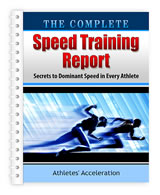3 Speed Drills You Should Never UseHow much faster can an athlete get under the right training? The answer to that question is one we try to provide answers for each and every week. One of the fastest ways to get there is through the use of effective speed drills. Why are speed drills so effective? Because, when done correctly, they train the athlete to move in an efficient and powerful way that takes advantage of the single most important factor in speed development. Force application. But not all speed drills are created equal. In fact, there are a few drills that I don't think you should use at all. These drills actually reinforce the bad habits that you're trying to break. What's worse is that they are drills that are used regularly in most programs. Remember, the goal with any technical training is to retrain the nervous system to fire the muscles in a way that promotes the most efficient and powerful running style possible. So you can't let athletes do drills that will erase all their efforts. When it comes to speed development, here are my top 3 drills you should immediately eliminate from your program if you want to run faster:
1. High Knees We're trying to get athletes to recover the heel underneath the hips, step over the support knee and then drive the foot down into the ground so that all the motion stays underneath the Center of Mass (CoM). The key point is keeping the ankle beneath the hips/CoM. Many athletes let that foot paw out or cycle out past the CoM and this results in a breaking action where the athlete is actually slowing down with each stride. Doing high knees supports the idea of bringing the foot out past the CoM instead of recovering, stepping over and driving down. Eliminate high knees in favor of more effective drills proven to improve running technique. 2. Butt Kicks This is another classic speed drill. However it teaches athletes that running involves knee flexion when, although it may look like the hamstring is involved through bending at the knee, it actually doesn't operate like that when running. The recovery of the active leg is not from the 'butt kick' action. When inexperienced athletes do butt kicks, it reinforces backside mechanics (where range of motion appears to take place primarily 'behind' the body) which is a tell tale sign that athletes are not producing any power while sprinting. Lack of power = lack of speed. Using butt kicks in your program gives athletes mixed signals as far as teaching them the right way to move. You have to get rid of butt kicks in favor of drills that promote efficiency and power. 3. 'B' Skip There are a few different names to this drill, but the problem remains the same. This drill starts out like an 'A' Skip (a great drill). But as soon as the active ankle clears the support knee, it all goes downhill. In the 'B' skip, the active ankle now drives out past the CoM as though the athlete were kicking in a door that was in front of them. From there they cycle/paw through with the foot landing, more or less, underneath the hips. This is simply unacceptable from a technical standpoint. One of the biggest problems athletes have is learning to drive the foot down into the ground as soon as it clears the knee. This leads to a number of extremely limiting problems. Regardless, this drill should be put on the shelf with only one exception... I do use this drill with some of my athletes. But only these athletes: The 'B' skip is an ideal drill for teaching lead leg mechanics with your hurdlers. But hurdling and sprinting are not the same. So, unless you're working with hurdlers, get rid of the 'B' skip and replace it with proven drills that are guaranteed to improve running form, mechanics and speed... Get More Information on the Ultimate Speed Training Resource by
Related Articles: Speed Training Drills | Speed Training: Arm Action Drill | Warm up Drills | 3 Speed Drills You Should Never Use | 'A' March Drill | 'A' Skip Drill | 'A' Run Speed Drill | Fast Leg Drill | Sprinting - Mechanical problems | Dynamic Warm-up Speed Drills |
|||||
